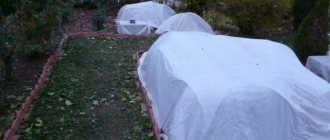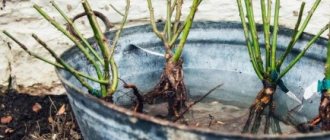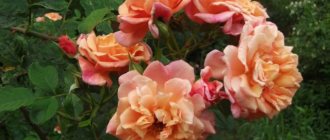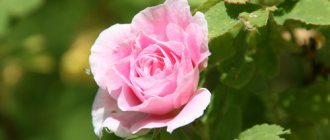History of the variety's creation
This variety of roses began to be bred at the beginning of the last century, when breeders from different countries of the European continent began to cross old popular varieties of roses with rose hips, or “flower queens” from different groups with each other. It is almost impossible to say exactly who created the world's first floribunda rose. But some flower growers and specialists give the palm to the German breeder Peter Lambert, while others give the palm to the Danish specialist Svend Poulsen.
Photo of floribunda freesia rose flowers
But one thing is known - the first representatives of a new class of roses - floribunda - were obtained as a result of crossing polyanthus and tea "flower queens" with each other. From the former, new types of roses received resistance to disease, long-lasting and abundant flowering, and from the latter, greater height of shoots and large flowers.
Later, when developing new varieties and hybrids of floribunda roses, breeders took musk, Chinese and a number of other varieties of this flowering shrub as a basis.
The variety of colors of rose petals in this category is amazing - almost the entire color gamut of flowers and their shades.
VARIETIES OF BEAUTIFUL FLORIBUNDA ROSES!
Floribunda rose Rumba Floribunda rose Midsummer "Midsummer" Floribunda rose Arthur Bell
Interesting!
The official ancestor of most roses of this variety is the American breeder Eugene Berner, who over the course of his work has bred more than 55 varieties of floribunda, which are still popular among flower growers from around the world.
The Floribunda Freesia rose was bred in 1973 by German breeders. It was obtained by grafting, and the following varieties of roses are usually used as rootstocks: Cattail or horsemeat. It can also be grafted onto ordinary rose hips.
Due to its high resistance to frost, the Freesia rose can be grown in most Russian regions, which is very important, for example, for Siberia or the Urals, where in winter many perennials simply freeze out due to cold weather.
Real review: “I didn’t become a favorite, and there are reasons for that”
Description of the Golden Delicious apple tree: characteristics, photos, reviews from gardeners
Below we give as an example one of the reviews from the site irecommend.ru.
Rose Larisa attracted me with her beautiful appearance in the picture and was purchased at the Podvorye garden center, along with other roses for which I came purposefully.
In the official photo, Rose Larisa really looks very attractive, but in reality, she did not become a favorite.
In the first year after planting, the rose grew considerably and produced a lot of buds. Only these buds partially fell off, and partially froze in an underdeveloped state and remained in this form for a very long time.
I attributed this to the fact that the plant needs to adapt and adapt to new conditions, so I wasn’t particularly worried. I didn’t really need flowering in the first year and it wasn’t even useful for first years. The only thing I wanted to make sure was that it wasn’t a re-sort, so I needed at least one flower.
I waited a long time and at the end of the season, several flowers finally bloomed. Yes, it was Larisa.
The next year, and to this day, the situation did not improve and the rose did not make me very happy all this time. The plant is very capricious and problematic. All diseases stick to her. It will not be possible to ignore it. It's out of the question. Anything - it immediately drops its buds, freezes or gets sick.
She manages to get sick, even when all her neighbors are feeling great. And this is considering that I know how to care for my roses and for the most part, they make me very happy and reciprocate.
Having left for two weeks, upon my return I found Larisa in a sad state. She caught black spot, the leaves were damaged, and subsequently most of them flew off completely. So it stood until the end of the season in the form of half-naked sticks with buds at the ends. And this despite the fact that the surroundings are completely without a single spot on the leaves. Black spotting is generally its scourge, it seems to me. But other diseases also cling to her with great enthusiasm. He just gaped and she already picked up something.
The bush is tall and tends upward (shrub). I don't like the shape of the bush. It grows chaotically and the crown is somewhat loose. And the leaf mass at the ends of the branches is clearly not enough. But with all this, there is something to praise Larisa for.
There are a lot of buds, some fall off, but many bloom and delight with the pleasant pearlescent pink color of flowers, beautifully shaped. After flowering, flowers do not lose their petals, but seem to become mummified and then break off on their own and fall along with the peduncle. The bush cleans itself and looks neat.
Larisa blooms quite late, in the second half of June. Then comes a break and a second wave in August. Moreover, the buds, having appeared, are in no hurry to open and can remain in an undeveloped state for quite a long time. You'll be tired of waiting for it to bloom. It seems to be all in buds, but not blooming. and it may never bloom, but simply drop its buds for no apparent reason.
The flowers are beautiful but can change depending on conditions. In the long, hot sun, they fade to dirty white, but in diffuse sunlight they retain their external attractiveness for a long time, and they don’t mind rain at all. In cooler times, flowers last longer and their color is more saturated.
Larisa winters well, both with and without shelter. She wakes up without any additional measures and in this regard absolutely without problems. For this reason alone, this rose continues to remain in my garden. I definitely won’t give her a second chance.
As for the aroma, there is almost none. But I would like him to still be present.
Conclusion:
Rose Larisa can be beautiful in bloom, but she is so capricious and unstable that there is no desire to work with her. This rose requires too much attention, with no guarantee of results. Let it grow, but I wouldn't buy it again. And I won't recommend it.
Rose Freesia: description of the variety and its characteristics
This rose is a perennial shrub with well-branched shoots and a tree-like central trunk.
Freesia rose bushes are of medium height, well-leafed shoots can reach a height of 0.6-0.75 m. The foliage is thin, round in shape with pointed tips and slightly jagged edges. The central vein is clearly visible, its color is dark emerald, as is the color of the leaf blades.
Brief overview of the floribunda freesia rose - video
The roots of an adult rose are powerful and well branched.
Interesting!
The flowering of the Freesia rose begins in the second ten days of June, its duration is almost until the first frost. The blooming buds are collected in racemose inflorescences, each of which can bloom up to 8 flowers almost simultaneously.
The buds are densely double, they can be up to 10 cm in diameter, the shape of the blooming flowers is cup-shaped. The color of the petals of the Freesia rose is bright yellow, sometimes lemon.
Photo of a floribunda freesia rose bud
During the flowering period, this shrub looks very beautiful and, thanks to the abundance of bright lemon flowers, is visible from afar. Rose Freesia is unpretentious to growing conditions; it grows and blooms equally well in the sun and in light shade. The Freesia rose variety is frost-resistant and can easily tolerate cold temperatures down to -28 degrees Celsius.
. The bushes also calmly tolerate spring return frosts with air temperatures down to 0-2 degrees.
Special mention should be made about the resistance of this floribunda rose to major diseases.
Freesia is practically not affected by the following diseases:
- viral in nature;
- black spotting;
- powdery mildew.
But the resistance of this perennial to scab and fusarium is below average.
Vivat, lemons!
If I associate Crown Princess Margaretha, described last time, with orange (not only in color, but also in light citrus notes in the aroma!), then “Freesia” is undoubtedly a bright lemon filled with juice. They grow next to us, in the company of other yellow and orange roses.
The aroma, of course, of “Freesia” is not as interesting and rich as that of Austin roses, it is delicate, more like a hybrid tea rose with a slightly greater depth, so to speak.
Flowering is abundant and long, with some break in the off-season, when the first wave has already completely faded, and the second then begins not immediately, but after a couple of weeks. At least this is how it works out for us; in another climate it may be different.
The most impressive thing about this rose is, of course, the color of the flowers - a rich, cold yellow, just like a slightly unripe lemon. No, it would be more correct to say “not overripe”!
The flowers are quite large for a floribunda, and are collected in small brushes, so you can even mistake this rose for a hybrid tea.
Bushes.
The bushes are small, compact, the height in the sun tends to be 50-60 cm, in partial shade they will be slightly higher. So if you plant it in the company of other roses, then it is unlikely to fit into the background.
The buds are more or less tolerant of rain, but after the first light frost (-1 -2 in the morning) the flowers looked pretty chewed. Although this is the problem with many roses. It’s a shame, you must admit, when there are 1-2 cold matinees in September, and then the weather is warm again, and the roses’ flowers are spoiled.
Overall the rose is wonderful, healthy and very bright!
Advantages of the variety
Experts include the main advantages of the Freesia rose variety:
- beautiful shape, large size and bright colors of flowers;
- abundant, long-lasting flowering;
- high resistance to cold, as well as resistance to spring cold snaps, therefore Freesia is grown in many regions with a short summer season and cold winters;
- high immunity to viral infections, black spot and powdery mildew;
- flowers are resistant to rain;
- unpretentiousness to growing conditions, it is possible to grow roses on poor soils and in the shade.
Features and advantages of floribunda roses - video
Among the disadvantages, it should be noted the low resistance of the flower to fusarium and scab, so it is necessary to carry out a number of preventive measures to prevent their development in the Freesia rose. Flower growers also note that the break between waves of flowering is quite long.
Frost protection
Despite the fact that floribunda is a frost-resistant variety, it is nevertheless better to cover the plant for the winter. Before the onset of cold weather, all buds must be cut off. All leaves and branches must be burned, because... Various disease carriers and pests can overwinter in them. It is recommended to cover the lower part immediately before the onset of cold weather (but in no case earlier! otherwise the root system may be supported) by 15-20 cm with earth. This will protect the root system and the seedlings themselves from freezing. Even if the upper part freezes, next spring the plant will develop perfectly from the lower part.
Diseases and pests of roses
It is not always possible to create conditions for the Freesia rose that completely guarantee the absence of diseases and the appearance of pests. Although this flower is resistant to powdery mildew, black spot and a number of viral infections, there are a number of diseases to which the immunity of this plant is low.
VARIETIES OF DELICATE AND BEAUTIFUL ROSES>>>
Park rose Louis Odier Rose “Mondial” Rose Frederic Mistral
Among the diseases, this perennial can be damaged by:
- Scabby.
To combat the disease, an alcohol tincture of iodine is used - it is used to treat damaged areas of foliage and stems. You should also treat the bushes twice (with an interval of a couple of weeks) with a solution of Fitosporin, Khoma or Bordeaux mixture. - against fusarium
- Fundazol or Maxim (as well as similar drugs). A solution of these substances is used to treat the vegetative mass of the rose twice with an interval of a couple of weeks. - To cope with chlorosis (yellow foliage),
it is necessary to apply fertilizer containing nitrogen to the tree trunks of the bush twice.
Photo of floribunda rose Freesia
Insect pests can also attack this flower:
- Aphids,
which can be combated with the following drugs:
Actellik, Antio, Karbofos, Rogor, Metathion.
Treating roses with solutions of the following insecticides can help
against leafhoppers Ditox, Tagore, Tzipi.
The bushes should be sprayed twice, the interval between treatments is 10 days.
Akrex, Izofen, Omaytom help well against spider mites You can also use other acaricidal preparations for spraying.
First visit to the dacha after winter: what things not to forget
February 15, 2020
On fine weekends, many owners of country houses experience an irresistible desire to get out of the city and come to the country. Outdoor recreation provides physical and mental recovery from the daily grind. However, upon arriving at the place, summer residents are faced with the fact that they need to redo a lot of things, and there is catastrophically little time. The first natural reaction to this state of affairs will be the temptation to redo everything in one or two days, but you shouldn’t do that. After all, working in the garden is just a reason to relax and gain strength, and not to leave the last of your health in the vegetable beds. Although spring is not endless, there will still be plenty of endless spring days. The main thing is to distribute tasks according to their priority and deal with them gradually, then work will turn into pleasure, and the results achieved will be much greater. Long-term practice shows that the ideal plan for re-opening a dacha after winter is the following: tidying up the dacha house; cleaning the garden and vegetable garden; cultivating the soil; preparing seedlings and planting them. The main thing is not to forget to get satisfaction from the process itself!
Rose floribunda Freesia: planting flowers
These beautiful roses should be planted in a place where they can be admired from different parts of the garden. In addition, Freesia also feels great in partial shade, so it can be given a place almost anywhere in the garden.
Photo of floribunda freesia rose in the garden
When choosing a site, you need to remember that a rose can be illuminated by sunlight in the morning and evening, but on a hot afternoon it is better for a light shadow to fall on the bushes - under the hot sun the buds fade and fade faster. In addition, foliage and petals can get burned due to the heat.
The lowland is also not for these flowering bushes - cold air accumulates there, harmful to the rose.
Although this perennial is unpretentious to the soils on which it grows, it still feels more comfortable on black earth or loamy soils.
in which a sufficient amount of fertilizer has been added. Good breathability and looseness are also positive qualities of the soil, thanks to which the rose will bloom more actively.
Useful article:
Soil salinization How to improve the soil, its fertility, composition, structure
If the site has solid alumina, then it is better to add organic matter (humus, compost, peat), as well as coarse river sand, to it in the fall before digging.
Sandstone loses moisture too quickly and quickly heats up under the sun's rays, so experienced gardeners add a large amount of clay soil to it. Humus and turf soil. The acidity of the soil for Freesia roses should be neutral or slightly alkaline. For acidification, it is better to add peat, and reduce the acidity with wood ash or lime.
Since the roots of this rose go deep into the ground, the groundwater level should be no closer to the soil surface than 1.5 m, otherwise the bushes may develop black spotting.
Rules for growing floribunda roses - video
Important!
In regions with short summers and cold winters, it is better to plant the Freesia rose in a permanent place in the spring - from the last ten days of April to the last ten days of May.
In autumn, Freesia roses can only be planted in September so that they have time to take root and get stronger before the onset of winter.
The depth of the planting holes is about 0.6 m.
A layer of drainage material up to 8-9 cm thick is laid on the bottom, then a layer of nutrient substrate, from which a mound is formed in the center of the hole.
Photo of preparing a planting hole for a rose
Before planting, seedlings should be placed in a solution of a root growth stimulator for half an hour, then the roots should be trimmed, removing damaged ones and shortening those that are too long.
A Freesia rose seedling is placed in the center of the hole, the roots are straightened, and the hole is filled with soil. The root collar is buried 2.5-3 cm into the soil. Then up to 10 liters of water are added to each plant. The tree trunk circles are mulched with humus on top.
Growing a flower, how to plant it correctly in open ground
In order for the floribunda rose Friesia to bloom beautifully and delight with its beautiful appearance, it must be planted correctly.
In what form is planting carried out?
Pachistachis yellow and red - how to care for the plant
Planting is carried out with tubers and seeds. Tubers are mainly used for planting. Seeds are grown in warm greenhouses.
What time does boarding take place?
Freesia is planted in open ground in early May, but if there is frost, then a little later. Favorable soil temperature is 10 degrees.
Selecting a location
Rose feels great in a place protected from drafts. Loves partial shade. The soil must be well permeable to moisture and air.
How to prepare the soil and flower for planting
The climbing rose Freesia will delight gardeners with its beautiful flowering in the right soil. Fertile, neutral, moisture-proof soil is good. You can add rotted compost or humus to it before planting. If the soil is highly acidic, then dolomite flour should be added. Before planting, you need to check that the soil is drained.
Note! It is important to prepare the corms for planting. Only those that have formed root embryos are suitable. They are pre-treated with a solution of phytosporin. You can keep the bulbs in a weak solution of potassium permanganate, but not more than half an hour.
Step by step landing procedure
The wells are pre-prepared. If the tubers are small, then they are planted at a distance of 3 cm, large ones - 5 cm from each other. A distance of 15 cm should be maintained between the rows. To protect the soil, mulch with peat. This will prevent the roots from overheating. After planting, watering is carried out.
Landing
Further care for Freesia roses
In the future, you need to carry out the following measures to care for the Floribunda Freesia rose:
- observe the irrigation regime;
- loosen tree trunk circles;
- remove weeds;
- apply fertilizers;
- carry out pruning.
In autumn, it is necessary to prepare roses for the onset of winter.
Although the Freesia rose is resistant to short periods of drought, it is better to water regularly.
VARIETY OF BEAUTIFUL ROSE CLIMING!
Rose variety Gloria Day
Important!
Water for irrigation should not be cold. In warm weather, add 1.5-2 buckets of water to each plant every 3-4 days. By the last ten days of August, the number of waterings is reduced, and at the beginning of autumn they are stopped completely.
In the first season, it is better to remove all emerging buds - the bushes should begin to grow, and the root system should grow well and become stronger, and early flowering will weaken the young plants. In early August, a pair of flowers should be left on each stem, on which fruits will then form. After this procedure, rose bushes will ripen better in the future, will not freeze in winter, and will bloom actively next summer.
Pruning freesia rose bushes
The best time for pruning is early spring, before the sap begins to flow in the shoots.
Be sure to leave those shoots on which flowers will appear in the current season.
Photo diagram of the degree of pruning of roses
Heavy pruning, in which no more than 4 buds are left on each shoot, is carried out to rejuvenate plants,
as well as after planting seedlings in a permanent place.
Average pruning of a Freesia rose includes refining the vines with the removal of excess, diseased and damaged shoots.
You should also trim the tops of the main shoots to encourage the growth of side stems.
Photo of floribunda rose pruning scheme
In autumn, it is necessary to carry out sanitary pruning of Freesia rose bushes,
in which young, non-lignified and weak stems, part of the shoots growing inside the bush are removed to prevent it from thickening, as well as all damaged branches.
During the summer, you should regularly remove all fading buds so that new flowers appear faster.
Rose Freesia: plant nutrition
In the first season, it is not necessary to fertilize the planted Freesia rose bushes,
if the soil was well fertilized during planting. Subsequently, in the spring, nitrogen-containing fertilizers are applied to these flowers, and in the summer and autumn, fertilizers containing superphosphate and potassium salts are applied.
CHOOSE BEAUTIFUL FLOWERS>>>
Calibrachoa Aquilegia Subulate Phlox
Preparing freesia roses for winter
The main thing when preparing Freesia rose bushes for winter is to cover the plants.
Such work begins when the thermometer drops to -5-7 degrees Celsius. The bushes are trimmed and the base is hilled up - better with earth than with other available materials.
Photo of covering roses for the winter
Spruce branches are placed between the plants and on top of them. Then greenhouse arcs are installed, on which the covering material is stretched, and polyethylene on top, leaving slits in the sides for ventilation.
Flower propagation
Freesia is propagated by tubers and corms. This is a painstaking task that may not always give a positive result.
When is it produced?
In early spring, seeds are planted. Reproduction by tubers and corms occurs in September.
Detailed description
Seeds are sown in a container on soil prepared from peat and sand. Then sprinkle with earth and water. The soil should not be allowed to dry out. In about a month, the seeds will germinate. When the seedlings reach 3 cm, they are thinned out and placed in a warm shelter.
Note! The tubers are planted in holes and mulched with humus. Corms are the easiest way to propagate. After digging up the plant, it is necessary to separate the bulbs from each other.
Rose Freesia: reviews from those who grow
Olga, 45 years old, Yaroslavl: In my garden in the recreation area, I made two lawns with soft emerald grass and planted several freesia rose bushes in each. When they began to bloom, it turned out so beautiful: against the background of bright green grass there are large yellow spots of the flowers of this rose. I always cover the rose for the winter, and during the summer I don’t forget to regularly water and feed it. My roses have not yet been damaged by disease.
Natalya, 50 years old, Volzhsky: My garden plot is not too large, so there are not enough sunny areas for all the plants. And I would like to plant some flowering perennials near the house, where, unfortunately, partial shade reigns. I was told to plant a Freesia rose there, which can grow and bloom beautifully in such conditions. Now in front of my country house there have been 3 bushes of this variety growing for three years and actively blooming until October!
Svetlana, 55 years old, Chelyabinsk region: For a long time I was looking for a variety of roses that would not freeze in winter in our climate. I planted these flowers in front of my house several times and covered them well, but they all froze until spring. And so I planted Freesia. I can say that this rose feels great in the summer, it doesn’t get sick, although since we fought against aphids, we dealt with it without any noticeable losses. In winter I covered it as written in the instructions. In the spring I opened the bushes and was surprised - not a single shoot died out.
The floribunda variety Freesia will definitely decorate the flowerbed and the entire garden plot, you just need to pay attention to it during the period of growth and flowering.
Recently searched:
50 days have passed
I would like to show how the third seedling is progressing. I didn't show it earlier because it wasn't blooming at all. However, it significantly outpaced the other two seedlings in terms of green mass. Even in the absence of flowers it is very pleasant to look at. I wonder what color it will bloom?
Beginning of September. Result
They say they count chickens in the fall. So we would like to summarize the experiment. Of the five Floribunda rose bushes originally purchased, two never sprouted. We planted them in the ground properly, but it looked like they were dead in the store. This relates to the question of which seedlings are better to buy: those that have already “woke up” and begun to grow, or those that are still “sleeping”, being in the state of sticks covered in wax. At first we thought that it was a waste of time to buy the ones that had already woken up. It is now clear that this is exactly what needs to be done.
The remaining three seedlings, released into the wild, regularly delighted us with flowers.
Contrary to our fears, the size of the inflorescences increased over and over again. Over time, they reached exactly the size that was shown on the boxes of seedlings. This is what two roses looked like in mid-September:
Before the cold weather, we trimmed the sprouts a little and covered them with flower pots for the winter. We hope that next spring we will be able to continue the story.
Back











